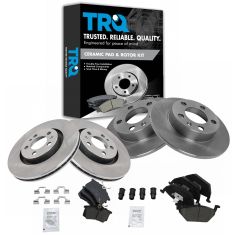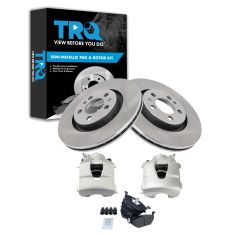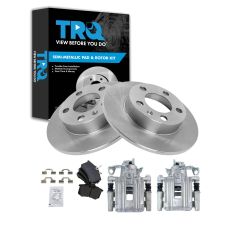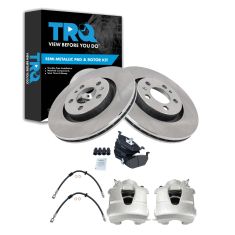1ABFS02421-VW Beetle Jetta Front & Rear Semi-Metallic Brake Pad & Rotor Kit TRQ BKA11641
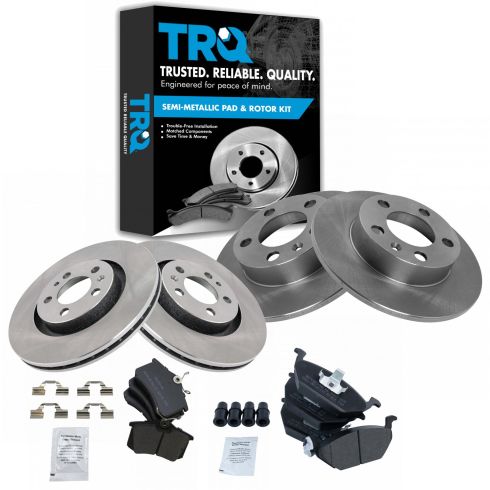
Replaces
1999 VW Jetta L4 2.0L From 8/01/99 Production Date with 5 Lug Wheels Front & Rear Semi-Metallic Brake Pad & Rotor Kit TRQ BKA11641

Product Reviews
Loading reviews
5.00/ 5.0
13
13 reviews
The bug is on the road again
June 26, 2017
Thanks a million. I am glad i found your parts. Not only are they reasonably priced but i found an entire package of everything i needed in one deal. I want have to worry about brakes or rotors for a while. Your deal was a great blessing to me financially. Raising a family and trying to do this would have been quite a task with the money involved. Looking at other part stores like advance would have cost me a weeks pay. Thanks again. God bless you and again thanks. Mike
Great deal! perfect fit for 2000 Beetle
September 5, 2017
These fit and worked out perfectly just do yourself a favor and either rent or purchase the tool to compress the rear caliper piston it will save you great time and aggravation.
Rotor / Disc Kit
July 16, 2018
Parts arrived quickly; correct fit; has performed properly.
UPS lost ship
August 24, 2018
Although UPS lost the first shipment and had me wait over a week to try and find it, when I called A1 they didn't hesitate about sending me everything again and only asked that I call them if the other package was delivered. I was delivered today and I called A1 and they are having UPS send a return label. Their services and prices are excellent and I will recommend them to everyone!
Regards to my brake order online for my Jetta
December 20, 2018
I received the parts in a timely manor, in inspecting the parts they came in good packaging and also fit my vehicle and came together without s hitch. The how to installation video was an amazing asset. Insuring all my future part orders will be made through A1 auto from here on out... I thank A1 auto for there products and there exceptional customer support and service.
February 6, 2019
Everything works and fits like it should. Will buy again.
Full break kit on vw beetle
March 6, 2019
All the parts were just like oem. Very high quality. Fits just like stock parts. What impresses me the most is how fast the parts shipped! Most purchases get to me in 2 days!
March 24, 2019
Great quality for the price. Would definetly buy this kit again.
Decent product for the price
May 8, 2019
The order came quickly and everything was correct. All parts had pictures on the website which was a plus. 1,000 miles on the brakes they are smooth and stop fast.
Installed on 2001 jetta 2.0 with pad sensors
August 30, 2019
These were nice they were a perfect match needed some adjustment on pads but direct fit. The videos were helpful .Im not a mechanic by trade ( Im a chef) I don't like spending 1200 on a brake job. I had no problems. I watched the video ,took the tire off invested 2 bucks for the 8 mm hex and had them installed within 2 hours, with most of my time taking coffee breaks. piece of cake. thanks a1.
Brake Pads and Rotors 2000 VW Jetta TDI
September 5, 2019
Fast delivery, Fit perfect. Work great.
Best brakes for the money, hands down!
December 3, 2019
These rotors are WONDERFUL! the guys at 1Aauto have great customer service, and their how-to videos are very informative. They ship fast, got this kit within a week and they were perfectly packaged, no flaws on the rotors or pads at all. The rotors are clean and VERY smooth, possibly the smoothest I've ever had. If you want quality products at a low price, you have to use 1Aauto!
Great parts
July 28, 2020
Everything fit as specified, works great super fast shipping
Customer Q&A
No questions have been asked about this item.
Volkswagen is a registered trademark of Volkswagen AG. 1A Auto is not affiliated with or sponsored by Volkswagen or Volkswagen AG.
See all trademarks.













